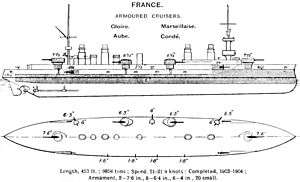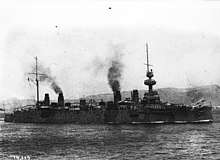French cruiser Marseillaise (1900)
The French cruiser Marseillaise was one of five Gloire-class armored cruisers built for the French Navy (Marine Nationale) in the first decade of the 20th century. Fitted with a mixed armament of 194-millimeter (7.6 in) and 164.7-millimeter (6.5 in) guns, the ships were designed for service with the battle fleet. Completed in 1903, Marseillaise joined her sister ships in the Northern Squadron (Escadre du Nord).
 A print showing Marseillaise at anchor | |
| History | |
|---|---|
| Name: | Marseillaise |
| Namesake: | La Marseillaise |
| Builder: | Arsenal de Brest |
| Laid down: | 10 January 1900 |
| Launched: | 14 July 1900 |
| Commissioned: | October 1903 |
| Struck: | 1929 |
| Fate: | Broken up, 1933 |
| General characteristics | |
| Class and type: | Gloire-class cruiser armored cruiser |
| Displacement: | 9,996 t (9,838 long tons) |
| Length: | 139.78 m (458 ft 7 in) (o/a) |
| Beam: | 20.2 m (66 ft 3 in) |
| Draft: | 7.55 m (24.8 ft) |
| Installed power: |
|
| Propulsion: | 3 shafts, 3 triple-expansion steam engines |
| Speed: | 21 knots (39 km/h; 24 mph) |
| Range: | 6,500 nautical miles (12,000 km; 7,500 mi) at 10 knots (19 km/h; 12 mph) |
| Complement: | 615 |
| Armament: |
|
| Armor: |
|
She served in the English Channel and the Atlantic as a convoy escort during World War I. She served as a gunnery training ship in 1925–29 and was broken up in 1933.
Design and description

The Gloire-class ships were designed as enlarged and improved versions of the preceding Gueydon class by Emile Bertin. The ships measured 139.78 meters (458 ft 7 in) overall, with a beam of 20.2 meters (66 ft 3 in) and a draft of 7.55 meters (24 ft 9 in). They displaced 9,996 metric tons (9,838 long tons). Their crew numbered 25 officers and 590 enlisted men.[1]
The sisters' propulsion machinery consisted of three vertical triple-expansion steam engines, each driving a single propeller shaft, using steam provided by water-tube boilers, but the types of machinery differed between them. Marseillaise had four-cylinder engines fed by 28 Belleville boilers that were designed to produce a total of 20,500 metric horsepower (15,100 kW) intended to give them a maximum speed of 21 knots (39 km/h; 24 mph). During her sea trials on 5 August 1903, the ship reached 21.64 knots (40.08 km/h; 24.90 mph) from 21,805 metric horsepower (16,038 kW). The cruisers carried enough coal to give them a range of 6,500 nautical miles (12,000 km; 7,500 mi) at a speed of 10 knots (19 km/h; 12 mph).[2]
Armament and armor
The main battery of the Gloire class consisted of two quick-firing (QF) 194 mm Modèle 1893–1896 guns mounted in single-gun turrets fore and aft of the superstructure. Their secondary armament comprised eight QF 164.7 mm Modèle 1893–1896 guns and six QF Canon de 100 mm (3.9 in) Modèle de 1893 guns. Half of the 164.7 mm guns were in two singe-gun wing turrets on each broadside and all of the remaining guns were on single mounts in casemates in the hull.[3] For defense against torpedo boats, they carried eighteen 47-millimeter (1.9 in) and four 37-millimeter (1.5 in) Hotchkiss guns, all of which were in single mounts. The sisters were also armed with five 450-millimeter (17.7 in) torpedo tubes, of which two were submerged and three above water. Two of these were on each broadside and the fifth tube was in the stern. All of the above-water tubes were on pivot mounts. The ships varied in the number of naval mines that they could carry and Marseillaise was fitted with storage for 14.[4]
The Gloire class were the first French armored cruisers to have their waterline armored belt made from Harvey face-hardened armor plates. The belt ranged in thickness from 70 to 150 millimeters (2.8 to 5.9 in). Because of manufacturing limitations, the thinner end plates were nickel steel. Behind the belt was a cofferdam, backed by a longitudinal watertight bulkhead. The upper armored deck met the top of the belt and had a total thickness of 34 millimeters (1.3 in) while the lower armored deck curved down to meet the bottom of the belt and had a uniform thickness of 45 millimeters (1.8 in).[5]
The main-gun turrets were protected by 161 millimeters (6.3 in) of Harvey armor, but their barbettes used 174-millimeter (6.9 in) plates of ordinary steel. The face and sides of the secondary turrets were 92 millimeters (3.6 in) thick and the plates protecting their barbettes were 102 millimeters (4 in) thick. The casemates protecting the 100-millimeter guns also had a thickness of 102 millimeters. The face and sides of the conning tower were 174 millimeters thick.[6]
Construction and career

Marseillaise, named after the French national anthem,[7] was authorized in the 1898 Naval Program and was ordered from the Arsenal de Brest on 19 June 1899. The ship was laid down on 10 January 1900, launched on 14 July 1900, and completed in October 1903.[8]
When World War I began, the cruiser was assigned to the Training Squadron which reinforced the 2nd Light Squadron at Brest.[9] She patrolled the English Channel into 1915, before she was transferred to the Caribbean and Atlantic for convoy-escort duties.[7]
In 1920, Marseillaise escorted SS George Washington as she ferried US President Woodrow Wilson to the USA.[10] The ship became a gunnery training ship in 1925–1929 and was broken up for scrap in 1933.[7]
Notes
- Jordan & Caresse, p. 123
- Jordan & Caresse, pp. 123, 131
- Chesneau & Kolesnik, p. 305
- Jordan & Caresse, pp. 125–126
- Jordan & Caresse, pp. 127–128
- Jordan & Caresse, pp. 128–130
- Silverstone, p. 104
- Jordan & Caresse, pp. 115, 117–118
- Moulin
- "Gloire Class". battleships-cruisers.co.uk. Retrieved 5 August 2015.
References
- Chesneau, Roger & Kolesnik, Eugene M., eds. (1979). Conway's All the World's Fighting Ships 1860–1905. Greenwich, UK: Conway Maritime Press. ISBN 0-8317-0302-4.
- "French Armored Cruiser Sully". Warship International. Toledo, Ohio: Naval Records Club. V (4): 324–26. 1968. ISSN 0043-0374.
- Jordan, John & Caresse, Philippe (2019). French Armoured Cruisers 1887–1932. Barnsley, UK: Seaforth Publishing. ISBN 978-1-5267-4118-9.
- Moulin, Jean (2013). "France: La Marine Nationale". In O'Hara, Vincent (ed.). To Crown the Waves: The Great Navies of the First World War. Annapolis, Maryland: Naval Institute Press. ISBN 978-1-61251-269-3.
- Silverstone, Paul H. (1984). Directory of the World's Capital Ships. New York: Hippocrene Books. ISBN 0-88254-979-0.